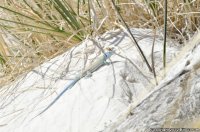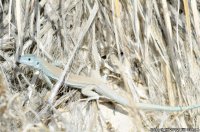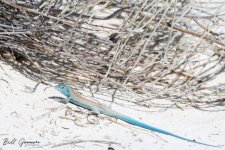| Range: |
 Found only in a small portion of the White Sands dunefield. Found only in a small portion of the White Sands dunefield. |
| Other Names: |
|
| Description: |
A long neck and body, powerful legs and a scaled pointed head, a pale blue lizard, whose underside is white. |
| Venom: |
None |
| Habitat: |
Sand dunes |
| Behavior: |
It is an active hunter roving over the dunes and searching under sumac branches, rosemary mint bushes, and rabbit brush. Using its forked tongue to smell, it seeks out prey to eat. The little white whiptail must use its coloration and speed to avoid being prey to birds (roadrunners, hawks), larger lizards, and snakes. Furthermore, its breakaway tail gives the little white whiptail a second chance to escape to brush or to its burrow. Known to climb yuccas. |
| Hibernation: |
Underground during cool months, usually emnerges in March or April. |
| Reproduction: |
After copulation in late spring or early summer, one to six eggs are laid. These emerge some 60 to 75 days later. |
| Diet: |
spiders, larvae of moths, butterflies, and beetles. |
Sources:



|







